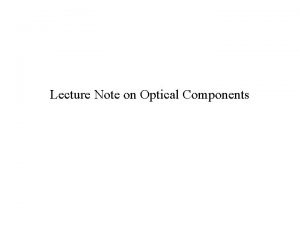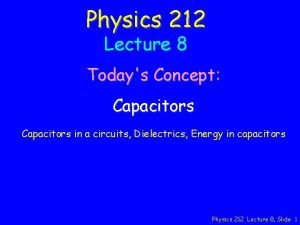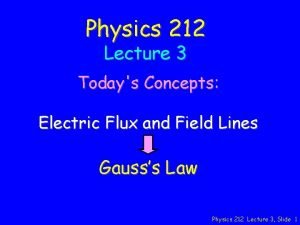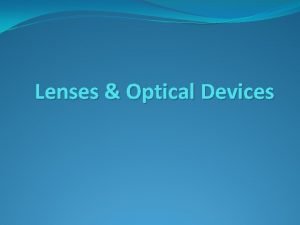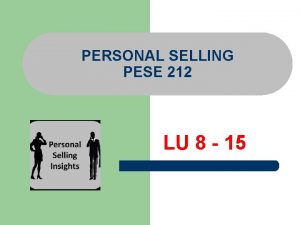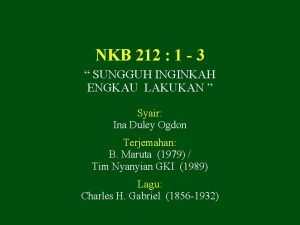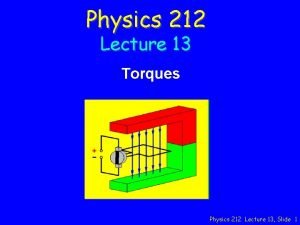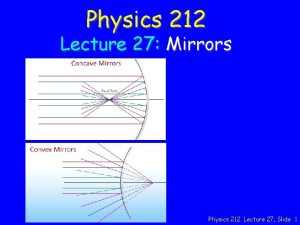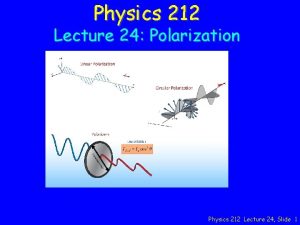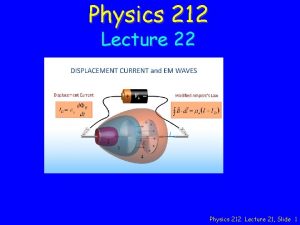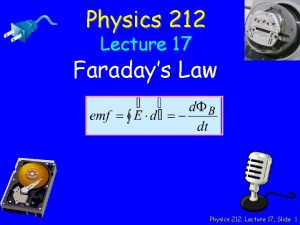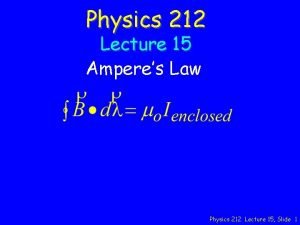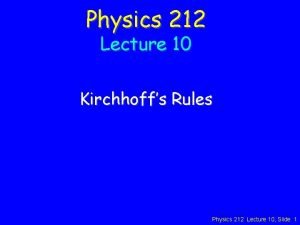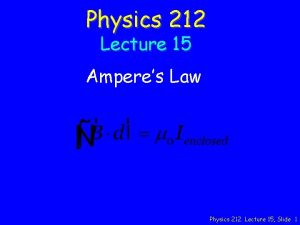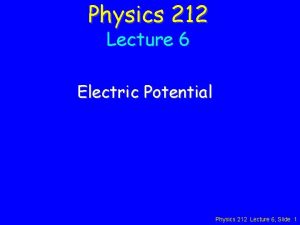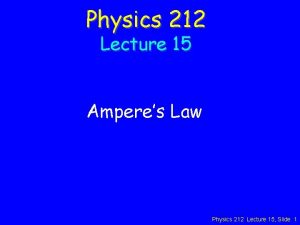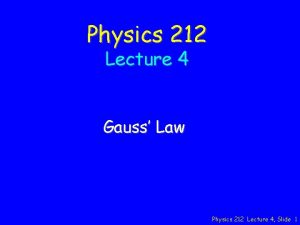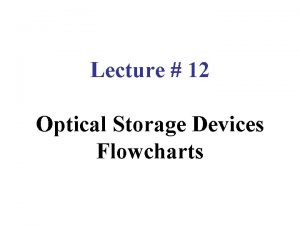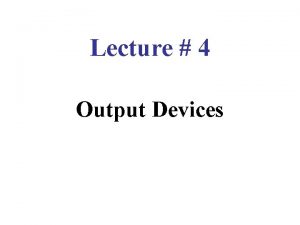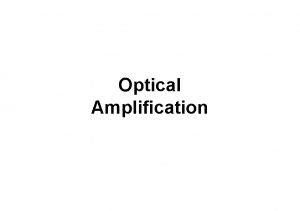Physics 212 Lecture 28 Optical Devices Physics 212



















- Slides: 19

Physics 212 Lecture 28 Optical Devices Physics 212 Lecture 28, Slide 1

Main Point 1 First, we developed a procedure to determine the image produced by a system of lenses by simply moving through the system one lens at a time, considering the object for a given lens to be the image from the preceding lens. Physics 212 Lecture 28, Slide 2

Main Point 2 Second, we introduced a model of the human eye as a converging lens with a somewhat variable focal length. This model was specified in terms of a near point and a far point. We determined the focal lengths of single lenses needed to correct far-sightedness and near-sightedness. Physics 212 Lecture 28, Slide 3

Main Point 3 Finally, we introduced the concept of angular magnification and used it to determine the magnifications of simple telescopes and microscopes. Physics 212 Lecture 28, Slide 4

System of Lenses • Trace rays through lenses, beginning with most upstream lens Image from first lens Becomes object for second lens Physics 212 Lecture 28, Slide 5

Physics 212 Lecture 28, Slide 6

System of Lenses • Virtual Objects are Possible !! Image from first lens Becomes object for second lens Physics 212 Lecture 28, Slide 7

Physics 212 Lecture 28, Slide 8

Checkpoint 1 Two people who wear glasses are camping. One of them is nearsighted and the other is farsighted. Which person’s glasses will be useful in starting a fire with the sun’s rays? A. The farsighted person’s glasses B. The nearsighted person’s glasses Physics 212 Lecture 28, Slide 9

Checkpoint 2 A person with normal vision (near point 28 cm) is standing in front of a plane mirror. What is the closest distance to the mirror the person can stand still see herself in focus? A. 14 cm B. 28 cm C. 56 cm Physics 212 Lecture 28, Slide 10

A parallel laser beam of width w 1 is incident on a two lens system as shown below. Checkpoint 3 Each lens is converging. The second lens has a larger focal length than the first (f 2 > f 1). What does the beam look like when it emerges from the second lens? A A. The beam is. Bconverging B. The beam is diverging C C. The beam is parallel to the axis with a width < w 1 D D. The beam is. Eparallel to the axis with a width = w 1 E. The beam is parallel to the axis with a width > w 1 Physics 212 Lecture 28, Slide 11

Normal Eye Physics 212 Lecture 28, Slide 12

Far-sighted Converging Lens creates virtual image at person’s near point Physics 212 Lecture 28, Slide 13

Near-sighted Fix with diverging lens that creates virtual image at far point. Physics 212 Lecture 28, Slide 14

Physics 212 Lecture 28, Slide 15

Multiple Lenses Exercises Two converging lenses are set up as shown. The focal length of each lens is 47 cm. The object is a light bulb located 70 cm in front of the first lens. What is the nature of the image from the first lens alone? (A) REAL UPRIGHT (B) REAL INVERTED (C) VIRTUAL UPRIGHT (D) VIRTUAL INVERTED Physics 212 Lecture 28, Slide 16

Physics 212 Lecture 28, Slide 17

Suppose we now decrease the initial object distance to 58 cm. Applying the lens equation, we find s 1’ = 2. 48 m What is the object distance s 2 for lens 2? (A) s 2 = -0. 48 m (B) s 2 = +0. 48 m (C) s 2 = -2. 48 m (D) s 2 = +2. 48 m (E) s 2 = +2. 58 m What is the nature of the FINAL image in terms of the ORIGINAL object? (A) REAL UPRIGHT (B) REAL INVERTED (C) VIRTUAL UPRIGHT (D) VIRTUAL INVERTED Physics 212 Lecture 28, Slide 18

Physics 212 Lecture 28, Slide 19
 Optical amplifiers lecture notes
Optical amplifiers lecture notes Q=vc physics
Q=vc physics Physics 212 gradebook
Physics 212 gradebook 01:640:244 lecture notes - lecture 15: plat, idah, farad
01:640:244 lecture notes - lecture 15: plat, idah, farad Optical disc
Optical disc Types of optical storage
Types of optical storage Which optical devices spread light apart?
Which optical devices spread light apart? Optical scanner devices are
Optical scanner devices are Power semiconductor devices lecture notes
Power semiconductor devices lecture notes Classical mechanics
Classical mechanics Physics 101 lecture notes pdf
Physics 101 lecture notes pdf Phy101 lecture 1
Phy101 lecture 1 Physics 101 lecture notes pdf
Physics 101 lecture notes pdf Waves 1 physics notes
Waves 1 physics notes Atmospheric physics lecture notes
Atmospheric physics lecture notes Pese 212
Pese 212 Nkb 212
Nkb 212 Ienf 212
Ienf 212 Et 212
Et 212 Et 212
Et 212
